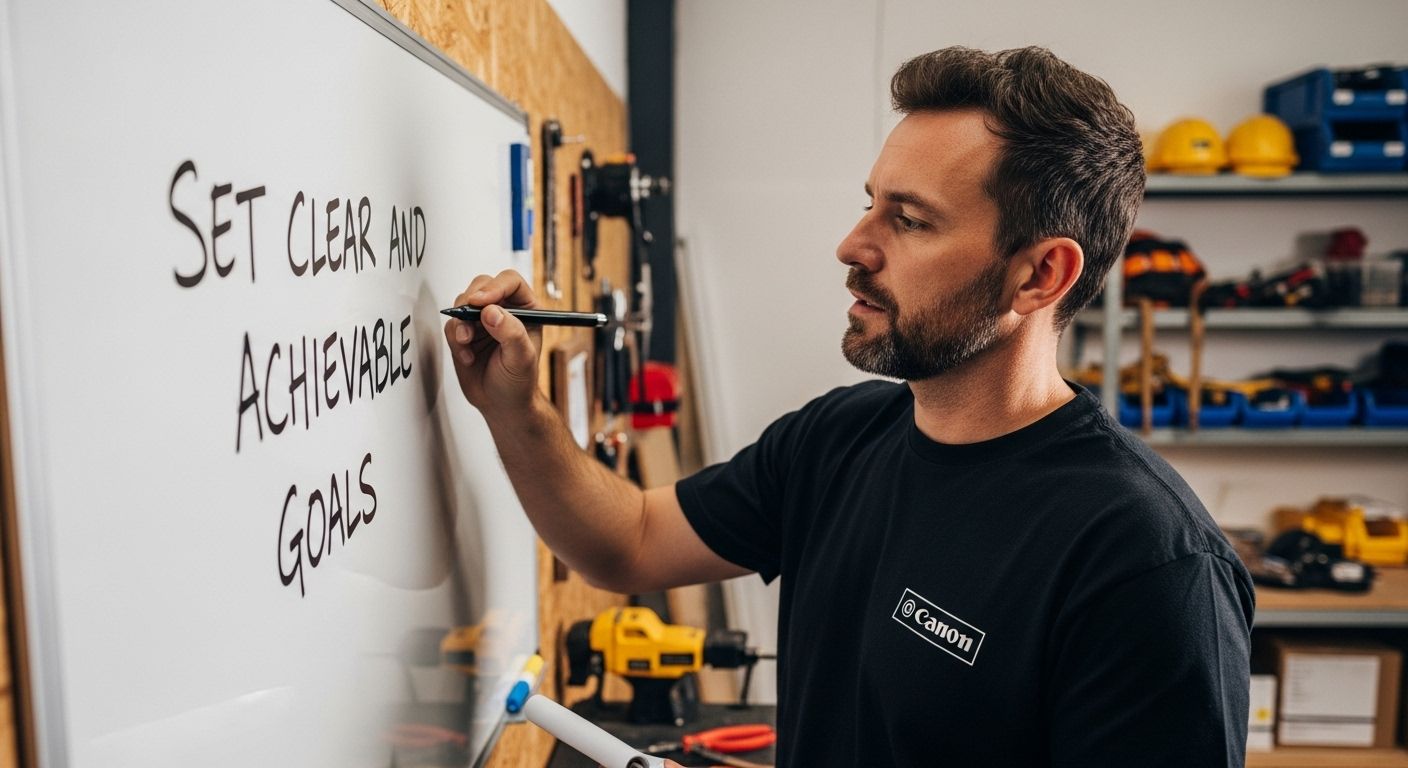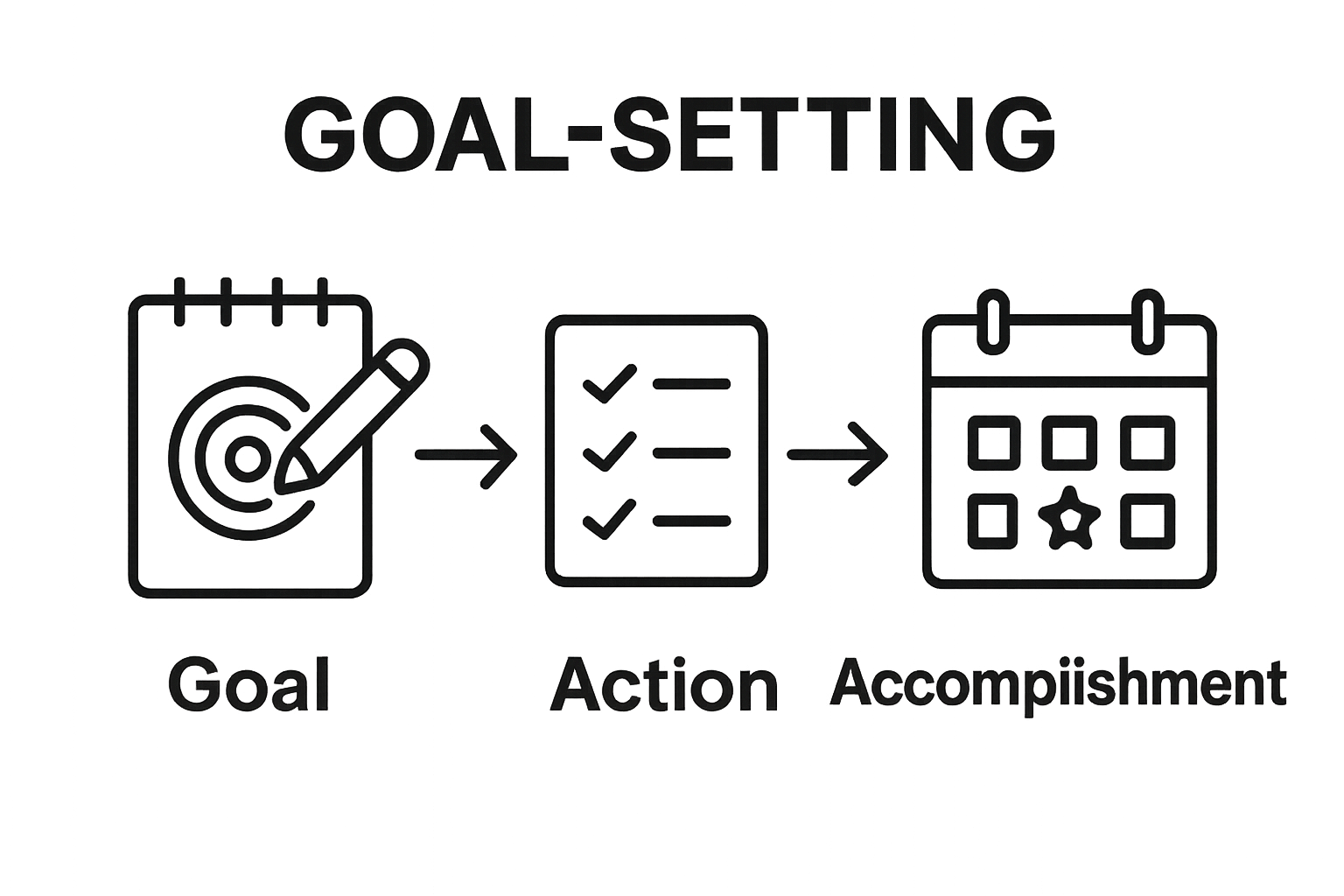
Staying motivated as a trades professional goes far beyond raw skill or grit. Workers who set clear, written goals are 42 percent more likely to achieve them, yet most just wing it day to day. Oddly enough, the real turning point usually comes not from hard work but from how you structure your daily habits and who you surround yourself with.
Table of Contents
- Step 1: Set Clear And Achievable Goals
- Step 2: Create A Daily Work Plan
- Step 3: Find And Maintain A Supportive Network
- Step 4: Establish A Reward System For Milestones
- Step 5: Continuously Reflect And Adjust Your Strategies
Quick Summary
| Key Point | Explanation |
|---|---|
| 1. Set SMART Goals | Define goals using the SMART framework: Specific, Measurable, Achievable, Relevant, and Time-bound to enhance clarity and focus. |
| 2. Develop a Daily Work Plan | Create a consistent daily plan that prioritizes tasks, turning broader goals into actionable daily steps for productive progress. |
| 3. Build a Supportive Network | Cultivate genuine relationships with mentors and peers to gain motivation, knowledge, and assistance in your trade work. |
| 4. Establish a Reward System | Design a personalized reward system to celebrate milestones and maintain motivation while working toward professional goals. |
| 5. Regularly Reflect and Adjust | Set aside time for weekly self-reflection to assess progress, identify challenges, and refine strategies for continuous improvement. |
Step 1: Set Clear and Achievable Goals
Motivation in trade work starts with knowing exactly where you’re headed. Setting clear and achievable goals isn’t just corporate jargon - it’s your roadmap to staying driven and focused, especially when the work gets tough. Think of your goals like a blueprint: detailed, specific, and designed to guide your daily actions.
Start by breaking down your professional objectives into bite sized, realistic targets. Instead of saying “I want to be successful,” define what success looks like in concrete terms. Maybe that means completing three additional certification courses this year, mastering a new technical skill, or increasing your productivity by 15%. These aren’t just numbers - they’re milestones that demonstrate your professional growth.
Crafting Your Goal Strategy
Goal setting requires more than wishful thinking. You need a systematic approach that transforms abstract desires into actionable plans. Begin by writing down your goals where you can see them daily. This might mean a whiteboard in your workspace, a notes app on your phone, or a dedicated journal. Visibility keeps your objectives front and center, transforming them from distant dreams to immediate priorities.
According to research from Psychology Today, individuals who write down their goals are 42% more likely to achieve them compared to those who just think about them. This isn’t magic - it’s about creating mental commitment and developing a clear roadmap.
Remember, your goals should follow the SMART framework: Specific, Measurable, Achievable, Relevant, and Time-bound. A vague goal like “get better at welding” becomes “complete advanced TIG welding certification by September” - suddenly, it’s something you can actually plan and execute.

Don’t just set goals. Break them down into weekly or monthly checkpoints. This approach transforms overwhelming objectives into manageable steps, keeping you motivated and providing constant evidence of your progress. Your goals are living documents - review and adjust them regularly, celebrating small wins and recalibrating when necessary.
Step 2: Create a Daily Work Plan
A solid daily work plan transforms scattered effort into strategic progress. Think of your work plan like a job site blueprint - without it, you’re just moving materials around without a clear construction strategy. Your daily plan becomes the tactical roadmap that turns your broader goals into actionable steps, ensuring you’re not just busy, but productively advancing your objectives.
Start by establishing a consistent planning routine. This might mean spending 15 minutes each evening preparing for the next day or dedicating the first 30 minutes of your morning to mapping out priorities. Consistency is key. Use a physical notebook, digital planner, or productivity app that fits your work style. The goal is creating a system you’ll actually use, not adding another task to your already full plate.
Prioritizing Your Daily Tasks
Effective daily planning means understanding the difference between urgent and important tasks. Not everything that screams for attention deserves your immediate focus. Begin by listing all potential tasks, then categorize them using a simple matrix: urgent and important, important but not urgent, urgent but not important, and neither urgent nor important.
According to research from Industrial Productivity Studies, workers who implement structured daily planning increase their productivity by up to 30%. This isn’t about cramming mor
e work into your day - it’s about working smarter and more strategically.
Your daily plan should include three to five primary objectives that directly contribute to your larger professional goals. These are your non-negotiable tasks that move the needle on your career development. Complement these with secondary tasks that can be flexibly scheduled or delegated. Build in buffer time for unexpected challenges - in trade work, something always comes up.
Verify your daily plan’s effectiveness by asking these key questions at day’s end: Did I complete my primary objectives? Were my tasks aligned with my broader goals? What can I adjust tomorrow? This reflective practice transforms your daily planning from a mechanical task to a dynamic growth strategy. Remember, a great work plan isn’t about perfection - it’s about consistent, intentional progress.
Here is a checklist to help you verify your planning and goal-setting approach each day. This table provides key questions you can ask yourself to ensure you are staying on track and making meaningful progress.
| Checklist Item | Purpose |
|---|---|
| Did I complete my primary objectives? | Confirms you accomplished the most important daily tasks |
| Were my tasks aligned with my broader goals? | Ensures your actions support your long-term objectives |
| What can I adjust tomorrow? | Helps improve your routine for greater efficiency |
| Did I set realistic task limits? | Prevents overcommitting and maintains motivation |
| Was buffer time sufficient for unexpected challenges? | Ensures flexibility and reduces stress |
Step 3: Find and Maintain a Supportive Network
In trade work, your network is more than just professional contacts - it’s your lifeline of support, knowledge, and motivation. Building a strong support system isn’t about collecting business cards or LinkedIn connections; it’s about cultivating genuine relationships that fuel your professional growth and keep you motivated during challenging times.
Start by recognizing that your network includes more than just colleagues. Your support network encompasses mentors, experienced tradespeople, apprentices at similar career stages, industry professionals, and even supportive family members who understand your professional journey. These connections provide different types of support - from technical advice to emotional encouragement.
Strategies for Building Meaningful Connections
Networking in trade work isn’t about schmoozing at fancy events. It’s about genuine interactions and mutual respect. Attend local trade association meetings, participate in professional workshops, and engage in online forums specific to your trade. These platforms offer opportunities to learn, share experiences, and build relationships with people who truly understand your professional challenges.
According to research from Industrial Motivation Studies, professionals who maintain active, supportive networks are 65% more likely to feel motivated and overcome workplace challenges. This isn’t just about collecting contacts - it’s about creating a support ecosystem that provides knowledge, inspiration, and practical assistance.
Be proactive in maintaining these relationships. Offer help before you need it. Share your own experiences, ask thoughtful questions, and demonstrate genuine interest in others’ professional journeys. Consider finding a mentor who has navigated similar career paths - someone who can provide guidance, share industry insights, and offer perspective during tough times.
Verify the strength of your network by asking yourself key questions: Am I regularly connecting with professional contacts? Have I learned something new from my network this month? Do I feel supported and inspired by these relationships? A robust network isn’t measured by quantity, but by the quality of interactions and the mutual support you provide and receive.
Step 4: Establish a Reward System for Milestones
Motivation isn’t just about grinding through work - it’s about recognizing your progress and giving yourself credit for the hard yards you’ve put in. Creating a personal reward system transforms your professional journey from a monotonous grind into a series of meaningful achievements, keeping you energized and focused on your goals.
Your reward system should be as unique as your trade work. Don’t just think about monetary rewards - consider rewards that genuinely excite and motivate you. This might mean investing in a new tool you’ve been eyeing, taking a skills workshop, enjoying a special meal, or setting aside dedicated time for a hobby you love. The key is creating incentives that feel meaningful and personally satisfying.
Below is a table outlining common types of rewards you can use for milestones in trade work. Use it to select incentives that genuinely excite you and keep your motivation high.
| Type of Reward | Example | Motivation Style |
|---|---|---|
| Tool or Equipment Upgrade | Purchase a new tool | Tangible reward |
| Training Opportunity | Attend a skills workshop | Professional growth |
| Special Activity | Enjoy a favorite meal or hobby | Personal enjoyment |
| Time Off | Schedule a day for self-care | Rest and recovery |
| Recognition | Share achievement with a mentor or group | Social motivation |
Designing Your Personal Motivation Framework
Start by breaking down your larger goals into smaller, achievable milestones. Each milestone should be specific, measurable, and worthy of celebration. For instance, if you’re working towards a advanced certification, your milestones might include completing specific study modules, passing practice exams, or accumulating required training hours. Attach a specific reward to each milestone that makes you genuinely look forward to achieving it.
According to research from Workplace Motivation Studies, professionals who implement personalized reward systems experience a 40% increase in sustained motivation and job satisfaction. This isn’t about creating an elaborate system, but about understanding what truly drives your personal enthusiasm.
Consider creating a visual tracking method for your milestones and rewards. This could be a dedicated notebook, a digital spreadsheet, or even a large wall chart where you can physically mark your progress. Seeing your achievements mapped out provides a powerful psychological boost, transforming abstract goals into tangible accomplishments.
Verify the effectiveness of your reward system by asking yourself critical questions: Do these rewards genuinely excite me? Am I looking forward to achieving these milestones? Are the rewards proportional to the effort required? Remember, the most effective motivation comes from rewards that feel authentic and meaningful to you - not from a generic template someone else designed.
Step 5: Continuously Reflect and Adjust Your Strategies
Motivation isn’t a set-it-and-forget-it process. It’s a dynamic journey that requires constant evaluation, honesty, and willingness to adapt. Think of your motivation strategy like a well-maintained tool - it needs regular inspection, cleaning, and occasional recalibration to perform at its best.
Set aside dedicated time for honest self-reflection. This isn’t about being hard on yourself, but about understanding what’s working, what isn’t, and how you can improve. Many trades professionals make the mistake of pushing forward without pausing to assess their approach. True growth happens when you’re willing to look critically at your methods and make intentional adjustments.
Creating a Personal Performance Review System
Establish a consistent reflection routine. This might mean a weekly 30-minute review where you assess your goals, track your progress, and identify potential roadblocks. Use a simple journal, digital notebook, or dedicated app to document your insights. The key is creating a system that feels natural and sustainable for your work style.
According to research from Professional Development Studies, professionals who implement regular self-reflection practices increase their productivity and job satisfaction by up to 35%. This isn’t about creating additional stress, but about developing a growth mindset that turns challenges into opportunities for improvement.
When reflecting, ask yourself tough but constructive questions. What goals did I achieve this week? Where did I struggle? What external factors impacted my motivation? What strategies worked well, and which ones need adjustment? Be brutally honest but compassionate with yourself. Recognize that motivation is a skill you’re continuously developing, not a fixed trait.
Verify the effectiveness of your reflection process by tracking your progress over time. Are you becoming more consistent? Are you identifying and addressing motivation challenges more quickly? Are your strategies becoming more refined and personalized? Remember, the goal isn’t perfection - it’s continuous improvement. Your motivation strategy should be as dynamic and adaptable as you are in your trade work.

Fuel Your Motivation with the Right Workwear from WorkwearComfort.com
Motivation in trade work is more than just setting goals or creating routines. It is about feeling strong and confident every day, even when the job gets challenging. When you think about achieving new milestones, maintaining reliable routines, and rewarding your progress, the right gear can play a crucial role. The article highlights steps like having a clear plan, staying comfortable on the job, and creating a reward system. If discomfort or lack of durability in your workwear is one of the barriers that dulls your drive, you are not alone. Many professionals lose momentum when their clothing cannot keep up with their hard work and long hours.

Why settle for less when you can upgrade your motivation from the ground up? WorkwearComfort.com offers quality apparel made for resilience, comfort, and style that matches your work ethic. From UPF 50+ sun protection hoodies to women’s workwear that empowers and protects, our range is tailored to fit the daily demands of trade professionals like you. Take the next step toward lasting motivation by choosing durable workwear that rewards your effort day after day. Shop now to transform both your routine and your mindset with every shift.
Frequently Asked Questions
What are some effective ways to set achievable goals in trade work?
Setting achievable goals in trade work involves using the SMART framework: ensure your goals are Specific, Measurable, Achievable, Relevant, and Time-bound. Break down larger goals into smaller, actionable milestones to keep track of your progress.
How can I create a daily work plan that maximizes productivity?
To create a daily work plan, dedicate time each day to prioritize your tasks based on urgency and importance. Use a matrix to categorize tasks and focus on three to five primary objectives that align with your overall goals, allowing for flexible scheduling of secondary tasks.
Why is building a supportive network important in trade work?
A supportive network in trade work provides access to mentorship, advice, and emotional encouragement. Genuine relationships with mentors, colleagues, and industry professionals can help you navigate challenges, share knowledge, and stay motivated in your career.
How can I effectively reward myself for achieving milestones?
To effectively reward yourself, attach specific and meaningful incentives to each milestone you achieve. Consider both tangible rewards, like new tools, and experiential ones, such as enjoyable activities, ensuring that they motivate you to continue progressing in your trade work.
Recommended
- Top Trades Gear and Apparel for 2025: Rugged Choices - WorkWear Comfort
- Women in the Trades 2025: Durable Workwear and Strong Careers - WorkWear Comfort
- What Is Workwear? A 2025 Guide for Hardworking Professionals - WorkWear Comfort
- Best Affordable Workwear Brands for Tough Jobs 2025 - WorkWear Comfort
- Psychology of Forex Trading: Mindset for Consistent Profits 2025
- Getting Tired of Food Safety Certificates? 10 Sources of Inspiration That’ll Rekindle Your Love - Probe IT


